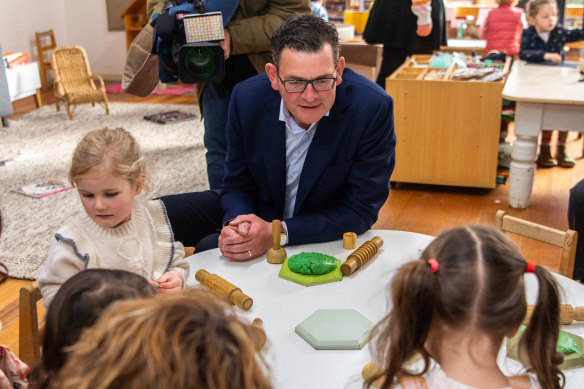Preschoolers from some of Victoria’s most disadvantaged postcodes may miss out on new state-owned affordable childcare centres, prompting calls from social welfare advocates for the Andrews government to prioritise communities in the greatest need.
The warning comes as an analysis by Deloitte Access Economics shows that so far, just one in four of the state’s most needy communities have been earmarked for one of the new centres.

Premier Daniel Andrews with preschoolers last year, when the government announced the funding for childcare centres.Credit: Justin McManus
The government last year announced a $9 billion overhaul of the preschool sector, which included subsidised kindergarten and 50 new government-run and low-fee integrated childcare centres, which would deliver childcare, kindergarten and pre-prep programs.
The government recently unveiled the location of 30 of the 50 centres, which was informed by work from the Mitchell Institute, a research organisation based at Victoria University. It identified so-called “childcare deserts” across the state and has highlighted concerns that some of the most developmentally vulnerable children often live in suburbs where childcare is difficult to find.
Social Ventures Australia (SVA) asked Deloitte Access Economics to identify 50 Victorian communities with high numbers of preschool children and higher levels of disadvantage that would benefit most from affordable integrated early learning services.
The analysis found that of the top 50 Victorian communities in need of integrated childcare centres – based on both the number of children in a suburb and the proportion who are developmentally vulnerable – just 13 are set to receive new government-owned and run childcare centres.
Areas in the greatest need of affordable childcare identified in the study included Campbellfield, Coolaroo, Meadow Heights and Broadmeadows, suburbs in Melbourne’s north that have so far missed out on integrated childcare sites.
Instead, suburbs such as Heidelberg West and Lynbrook, as well as Portarlington on the Bellarine Peninsula and Creswick, near Ballarat, will receive government-run early learning centres.
In regional Victoria, Deloitte identified Morwell in the Latrobe Valley and Corio, north of Geelong, as areas of concentrated disadvantage and with high numbers of preschool-aged children. But those areas have not been allocated integrated low-cost learning centres.
Emma Sydenham, the director of Early Childhood at SVA, welcomed the commitment to build 50 new integrated early learning centres, but called on the government to prioritise children, parents and the vulnerable communities identified in the Deloitte report.
“The rollout of integrated early learning centres across Victoria is a once-in-a-generation opportunity to make sure more children who face some of the biggest challenges are given their best chance in life,” Sydenham said.
“We encourage Premier [Daniel] Andrews and [Early Childhood] Minister [Ingrid] Stitt to build the new centres they have promised in communities where they will have the biggest impact on ensuring more Victoria children start school ready and thriving.”
Sydenham said locating centres in communities where children and families experiencing disadvantage maximised the return on investment because evidence showed these services reduced later costs in other areas such as justice, health and social services.
A government spokesperson said the Department of Education uses “a robust data-driven process to identify areas of need”, which considered disadvantage in communities, alongside analysis of existing supply and likely demand for childcare as Victoria continues to grow.
The government has promised that, where possible, the new centres will be located with other community facilities such as maternal and child health services, playgroups, schools and health services adopting an integrated model.
Victoria has, until recently, lagged other states in delivering integrated child and family centres that offer kindergarten, daycare, maternal and child health and medical services.
Deloitte found children who experience socio-economic disadvantage had “the most to gain” from the integrated childcare model as the hubs met “the needs of vulnerable and disadvantaged families in a uniquely integrated and efficient way – and, in doing so, helping to bridge the gaps in development and wellbeing outcomes that have proven stubbornly persistent in Australia”.
Sydenham said integrated child and family centres can provide holistically to the needs of children and families, and urged the government to consider doubling the number of centres promised.
“The evidence shows that investing in centres like these, with support for kids, mums and dads that go above and beyond early education is one of the most effective actions a government can take to improve the life outcomes for children who are at risk of falling behind,” she said.
The Morning Edition newsletter is our guide to the day’s most important and interesting stories, analysis and insights. Sign up here.